The Spatiotemporal Heterogeneities of Deindustrialization in Mainland China
Abstract
1. Introduction
2. Methodology and Data Sources
2.1. Methodology
2.1.1. Measurement Criteria for Deindustrialization
2.1.2. Mfuzz Cluster Analysis
2.1.3. The ARIMA Time Trend Model
2.1.4. Geodetector
2.1.5. Panel Data Model
2.1.6. The Spatiotemporal Measurement Model
2.2. Data Sources
3. The Spatiotemporal Characteristics of Deindustrialization in China
3.1. The Overall Evolution Characteristics
3.2. The Regional Spatiotemporal Heterogeneous Characteristics
3.3. The Provincial Spatiotemporal Heterogeneous Characteristics
4. The Empirical Results and Discussions
4.1. Factor Detection
4.2. Interaction Detection
4.3. Spatial Durbin Analysis
4.4. Fixed-Effects Model
5. Forecasts of Deindustrialization
5.1. Overall Forecast
5.2. Provincial Forecast
6. Conclusions and Policy Implications
6.1. Main Conclusions
6.2. Policy Implications
6.3. Research Prospects
Author Contributions
Funding
Institutional Review Board Statement
Informed Consent Statement
Data Availability Statement
Acknowledgments
Conflicts of Interest
| 1 | http://mfuzz.sysbiolab.eu (accessed on 23 November 2025). |
| 2 | The eastern region includes Beijing, Tianjin, Hebei, Liaoning, Shanghai, Jiangsu, Zhejiang, Fujian, Shandong, Guangdong, and Hainan. The central region includes Shanxi, Jilin, Heilongjiang, Anhui, Jiangxi, Henan, Hubei, and Hunan. The western region includes Gansu, Guangxi, Guizhou, Inner Mongolia, Ningxia, Qinghai, Shaanxi, Sichuan, Tibet, Xinjiang, Yunnan, and Chongqing. |
References
- Destek, M.A.; Hossain, M.R.; Khan, Z. Premature deindustrialization and environmental degradation. Gondwana Res. 2024, 127, 199–210. [Google Scholar] [CrossRef]
- Rodrik, D. Premature deindustrialization. J. Econ. Growth 2016, 21, 1–33. [Google Scholar] [CrossRef]
- Fujiwara, I.; Matsuyama, K. A technology-gap model of ‘Premature’ Deindustrialization. Am. Econ. Rev. 2024, 114, 3714–3745. [Google Scholar] [CrossRef]
- Zou, T. Technological innovation promotes industrial upgrading: An analytical framework. Struct. Change Econ. Dyn. 2024, 70, 150–167. [Google Scholar] [CrossRef]
- Myovella, G.; Karacuka, M.; Haucap, J. Digitalization and economic growth: A comparative analysis of Sub-Saharan Africa and OECD economies. Telecommun. Policy 2020, 44, 101856. [Google Scholar] [CrossRef]
- Szirmai, A.; Verspagen, B. Manufacturing and economic growth in developing countries, 1950–2005. Struct. Change Econ. Dyn. 2015, 34, 46–59. [Google Scholar] [CrossRef]
- Emery, J. Geographies of deindustrialization and the working-class: Industrial ruination, legacies, and affect. Geogr. Compass 2019, 13, e12417. [Google Scholar] [CrossRef]
- Van Neuss, L. Globalization and deindustrialization in advanced countries. Struct. Change Econ. Dyn. 2018, 45, 49–63. [Google Scholar] [CrossRef]
- Alderson, A.S. Explaining deindustrialization: Globalization, failure, or success? Am. Sociol. Rev. 1999, 64, 701–721. [Google Scholar] [CrossRef]
- Barry, B.; Bennett, H. The Deindustrialization of America: Plant Closings, Community Abandonment, and the Dismantling of Basic Industry; Basic Books, Inc.: New York, NY, USA, 1984. [Google Scholar] [CrossRef]
- James, J.; Ebin, V. Succeeding with industrialization: The experience of Germany and Japan as late industrializers. Int. J. Mech. Ind. Technol. 2021, 9, 18–24. Available online: https://www.researchpublish.com (accessed on 1 January 2023).
- Taguchi, H.; Tsukada, Y. Premature deindustrialization risk in Asian latecomer developing economies. Asian Econ. Pap. 2022, 21, 61–77. [Google Scholar] [CrossRef]
- Nagaraj, R. India’s premature deindustrialization and falling investment rate in the 2010s. World Dev. 2025, 191, 106954. [Google Scholar] [CrossRef]
- Kollmeyer, C.; Pichler, F. Is deindustrialization causing high unemployment in affluent countries? Evidence from 16 OECD countries, 1970–2003. Soc. Forces 2013, 91, 785–812. [Google Scholar] [CrossRef]
- Lee, C.S. International migration, deindustrialization and union decline in 16 affluent OECD countries, 1962–1997. Soc. Forces 2005, 84, 71–88. [Google Scholar] [CrossRef]
- Teimouri, S.; Zietz, J. Coping with deindustrialization: A panel study for early OECD countries. Struct. Change Econ. Dyn. 2020, 54, 26–41. [Google Scholar] [CrossRef]
- Gosens, J.; Lu, Y. Prospects for global market expansion of China’s wind turbine manufacturing industry. Energy Policy 2014, 67, 301–318. [Google Scholar] [CrossRef]
- Yu, C.; Luo, Z. What are China’s real gains within global value chains? Measuring domestic value added in China’s exports of manufactures. China Econ. Rev. 2018, 47, 263–273. [Google Scholar] [CrossRef]
- Li, L. China’s manufacturing locus in 2025: With a comparison of “Made-in-China 2025” and “Industry 4.0”. Technol. Forecast. Soc. Change 2018, 135, 66–74. [Google Scholar] [CrossRef]
- Golley, J. Regional patterns of industrial development during China’s economic transition. Econ. Transit. 2002, 10, 761–801. [Google Scholar] [CrossRef]
- Wei, Y.H.D.; Liefner, I. Globalization, industrial restructuring, and regional development in China. Appl. Geogr. 2012, 32, 102–105. [Google Scholar] [CrossRef]
- Cheng, D. The development of the service industry in the modern economy: Mechanisms and implications for China. China Financ. Econ. Rev. 2013, 1, 3. [Google Scholar] [CrossRef]
- Liao, J. The rise of the service sector in China. China Econ. Rev. 2020, 59, 101385. [Google Scholar] [CrossRef]
- Wu, Y. China’s services sector: The new engine of economic growth. Eurasian Geogr. Econ. 2015, 56, 618–634. [Google Scholar] [CrossRef]
- Rekha, R.; Suresh, B.M. Premature deindustrialisation and growth slowdowns in middle-income countries. Struct. Change Econ. Dyn. 2022, 62, 377–389. [Google Scholar] [CrossRef]
- Yang, H.; Zhang, F.; He, Y. Exploring the effect of producer services and manufacturing industrial co-agglomeration on the ecological environment pollution control in China. Environ. Dev. Sustain. 2021, 23, 16119–16144. [Google Scholar] [CrossRef]
- Kuznets, S. Modern Economic Growth: Rate, Structure and Spread; Yale University Press: New Haven, CT, USA; London, UK, 1966. [Google Scholar]
- Huang, Q. China’s Industrialization Process; Springer: Singapore, 2018. [Google Scholar]
- Anastasi, A.W.D. China’s imbalances and the shrinking of the development space. Trans. Inst. Br. Geogr. 1992, 17, 481–494. [Google Scholar] [CrossRef]
- Neel, P. Broken Circle: Premature deindustrialization, Chinese capital exports, and the stumbling development of new territorial industrial complexes. Int. Labor Work.-Cl. Hist. 2022, 102, 94–123. [Google Scholar] [CrossRef]
- Lin, B.; Zhou, Y. How does vertical fiscal imbalance affect the upgrading of industrial structure? Empirical evidence from China. Technol. Forecast. Soc. Change 2021, 170, 120886. [Google Scholar] [CrossRef]
- Tang, Y.; Zhu, H.; Yang, J. The asymmetric effects of economic growth, urbanization and deindustrialization on carbon emissions: Evidence from China. Energy Rep. 2022, 8 (Suppl. 7), 513–521. [Google Scholar] [CrossRef]
- Gill, I.S.; Kharas, H.J.; Bhattasali, D.; Brahmbhatt, M. An East Asian Renaissance: Ideas for Economic Growth; World Bank Publications: Washington, DC, USA, 2007; Volume 22, pp. 57–59. [Google Scholar] [CrossRef]
- Haraguchi, N.; Cheng, C.F.C.; Smeets, E. The importance of manufacturing in economic development: Has this changed? World Dev. 2017, 93, 293–315. [Google Scholar] [CrossRef]
- High, S. The radical origins of the deindustrialization thesis: From dependency to capital flight and community abandonment. Labour/Le Trav. 2023, 91, 31–56. [Google Scholar] [CrossRef]
- Oreiro, J.L.; Manarin, L.L.; Gala, P. Deindustrialization, economic complexity and exchange rate overvaluation: The case of Brazil (1998–2017). PSL Q. Rev. 2020, 73, 313–341. [Google Scholar] [CrossRef]
- Saeger, S.S. Globalization and deindustrialization: Myth and reality in the OECD. Rev. World Econ. 1997, 133, 579–608. [Google Scholar] [CrossRef]
- Tregenna, F. Characterising deindustrialisation: An analysis of changes in manufacturing employment and output internationally. Camb. J. Econ. 2009, 33, 433–466. [Google Scholar] [CrossRef]
- Di Berardino, C.; Doganieri, I.; Onesti, G. Deindustrialization in the EU between transformation and decline. East. Eur. Econ. 2021, 59, 225–249. [Google Scholar] [CrossRef]
- Rowthorn, R.; Ramaswamy, R. Growth, trade, and deindustrialization. IMF Econ. Rev. 1999, 46, 18–41. [Google Scholar] [CrossRef]
- Liu, L.; An, S. Deindustrialization and the incidence of poverty: Empirical evidence from developing countries. Technol. Forecast. Soc. Change 2023, 187, 122202. [Google Scholar] [CrossRef]
- Schindler, S.; Gillespie, T.; Banks, N.; Bayırbağ, M.K.; Burte, H.; Kanai, J.M.; Sami, N. Deindustrialization in cities of the Global South. Area Dev. Policy 2020, 5, 283–304. [Google Scholar] [CrossRef]
- Felipe, J.; Mehta, A.; Rhee, C. Manufacturing matters, but it’s the jobs that count. Camb. J. Econ. 2019, 43, 139–168. [Google Scholar] [CrossRef]
- Skinner, J.F.; Garibaldi, J.M.; Curnow, J.; Ifeachor, E.C. Intelligent fetal heart rate analysis. In Proceedings of the First International Conference on Advances in Medical Signal and Information Processing, Bristol, UK, 4–6 September 2000; IEEE: London, UK, 2000; pp. 14–21. [Google Scholar] [CrossRef]
- Wang, J.-F.; Li, X.-H.; Christakos, G.; Liao, Y.-L.; Zhang, T.; Gu, X.; Zheng, X.-Y. Geographical detectors-based health risk assessment and its application in the neural tube defects study of the Heshun Region, China. Int. J. Geogr. Inf. Sci. 2010, 24, 107–127. [Google Scholar] [CrossRef]
- Lee, L.F.; Yu, J. Identification of spatial Durbin panel models. J. Appl. Econom. 2016, 31, 133–162. [Google Scholar] [CrossRef]
- Dai, Z.; Niu, Y.; Zhang, H.; Niu, X. Impact of the transforming and upgrading of China’s labor-intensive manufacturing industry on the labor market. Sustainability 2022, 14, 13750. [Google Scholar] [CrossRef]
- Sargent, J.; Matthews, L. Capital intensity, technology intensity, and skill development in post China/WTO maquiladoras. World Dev. 2008, 36, 541–559. [Google Scholar] [CrossRef]
- Li, L.; Ge, F.; Jiang, Y.; An, Z.; Li, N.; Zhang, Z.; Liu, H.; Li, J.; Liang, D. Research status and development trends of Inorganic salt lake resource extraction based on bibliometric analysis. Sustainability 2025, 17, 121. [Google Scholar] [CrossRef]
- Liu, Y.; Zhang, X. Does labor mobility follow the inter-regional transfer of labor-intensive manufacturing? The spatial choices of China’s migrant workers. Habitat Int. 2022, 124, 102559. [Google Scholar] [CrossRef]
- Mao, Q.; Wang, F.; Li, J.; Dong, S. Evolving a core-periphery pattern of manufacturing industries across Chinese provinces. J. Geogr. Sci. 2014, 24, 924–942. [Google Scholar] [CrossRef]
- Wang, W.; Zhou, L.; Chen, W.; Wu, C. Research on the coordination characteristics and interaction between the innovation-driven development and green development of the Yangtze River Economic Belt in China. Environ. Sci. Pollut. Res. 2022, 29, 22952–22969. [Google Scholar] [CrossRef]
- Makkonen, T.; Williams, A.M.; Mitze, T.; Weidenfeld, A. Science and technology cooperation in cross-border regions: A proximity approach with evidence for Northern Europe. Eur. Plan. Stud. 2018, 26, 1961–1979. [Google Scholar] [CrossRef]
- He, J.; Chen, J.; Xiao, J.; Zhao, T.; Cao, P. Defining important areas for ecosystem conservation in Qinghai province under the policy of ecological red line. Sustainability 2023, 15, 5524. [Google Scholar] [CrossRef]
- Wang, Z.; Wei, W. Cross-Border Economic Cooperation Between China and Southeast Asian Countries; Springer: Singapore, 2022. [Google Scholar] [CrossRef]
- Sun, Y.; Ma, A.; Su, H.; Su, S.; Chen, F.; Wang, W.; Weng, M. Does the establishment of development zones really improve industrial land use efficiency? Implications for China’s high-quality development policy. Land Use Policy 2020, 90, 104265. [Google Scholar] [CrossRef]
- Deng, X.; Hou, Q.; Shen, J. Can digital transformation reduce R&D investment disruption during the top executive transition period? Manag. Decis. Econ. 2024, 45, 1901–1926. [Google Scholar] [CrossRef]
- Zhou, Y.; Zang, J.; Miao, Z.; Minshall, T. Upgrading pathways of intelligent manufacturing in China: Transitioning across technological paradigms. Engineering 2019, 5, 691–701. [Google Scholar] [CrossRef]
- Liu, H.; Zhao, H.; Li, S. Future social change of manufacturing and service industries: Service-oriented manufacturing under the integration of innovation-flows drive. Technol. Forecast. Soc. Change 2023, 196, 122808. [Google Scholar] [CrossRef]
- Sagar, A.D.; Frosch, R.A. A perspective on industrial ecology and its application to a metals-industry ecosystem. J. Clean. Prod. 1997, 5, 39–45. [Google Scholar] [CrossRef]

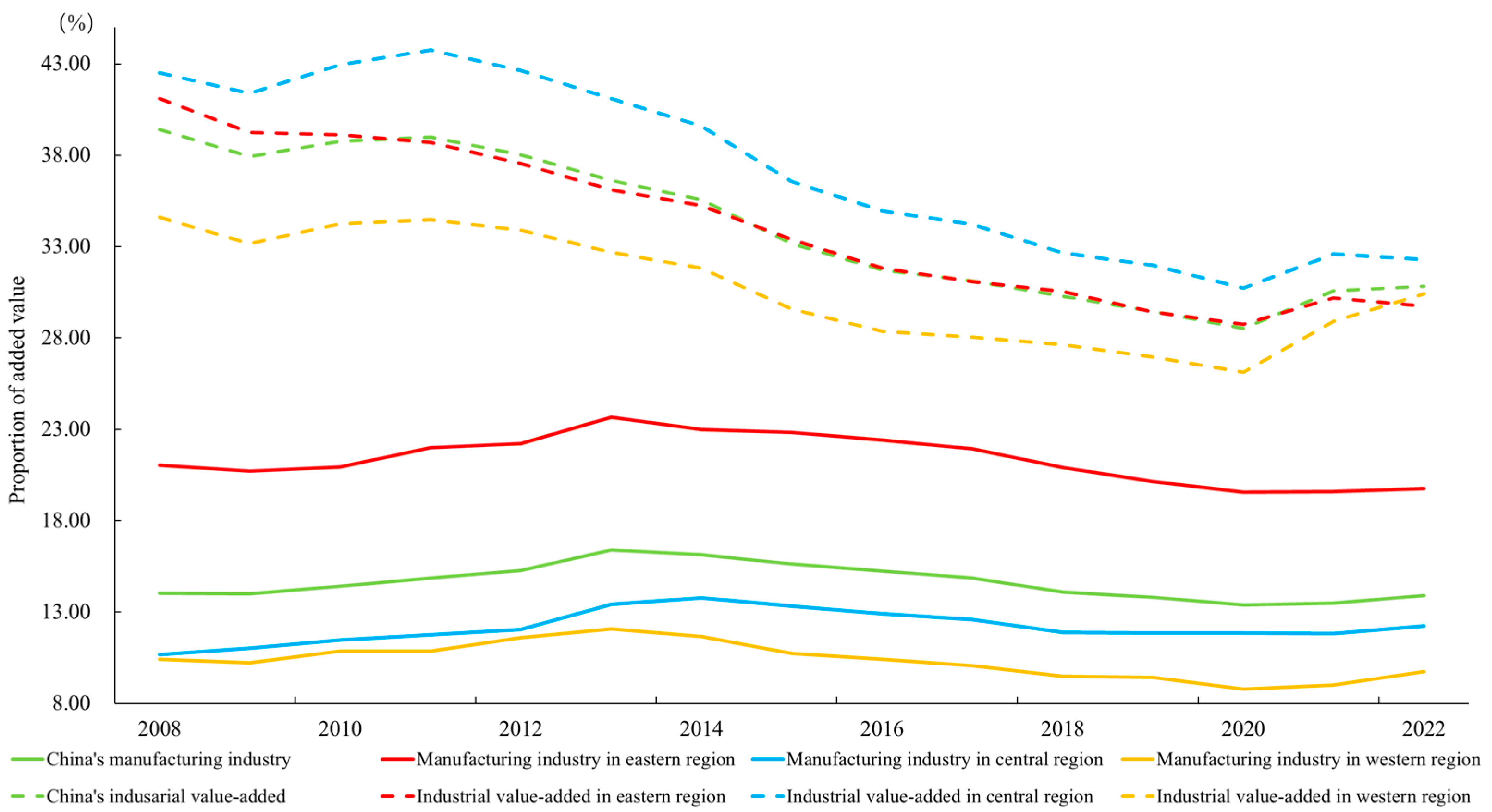
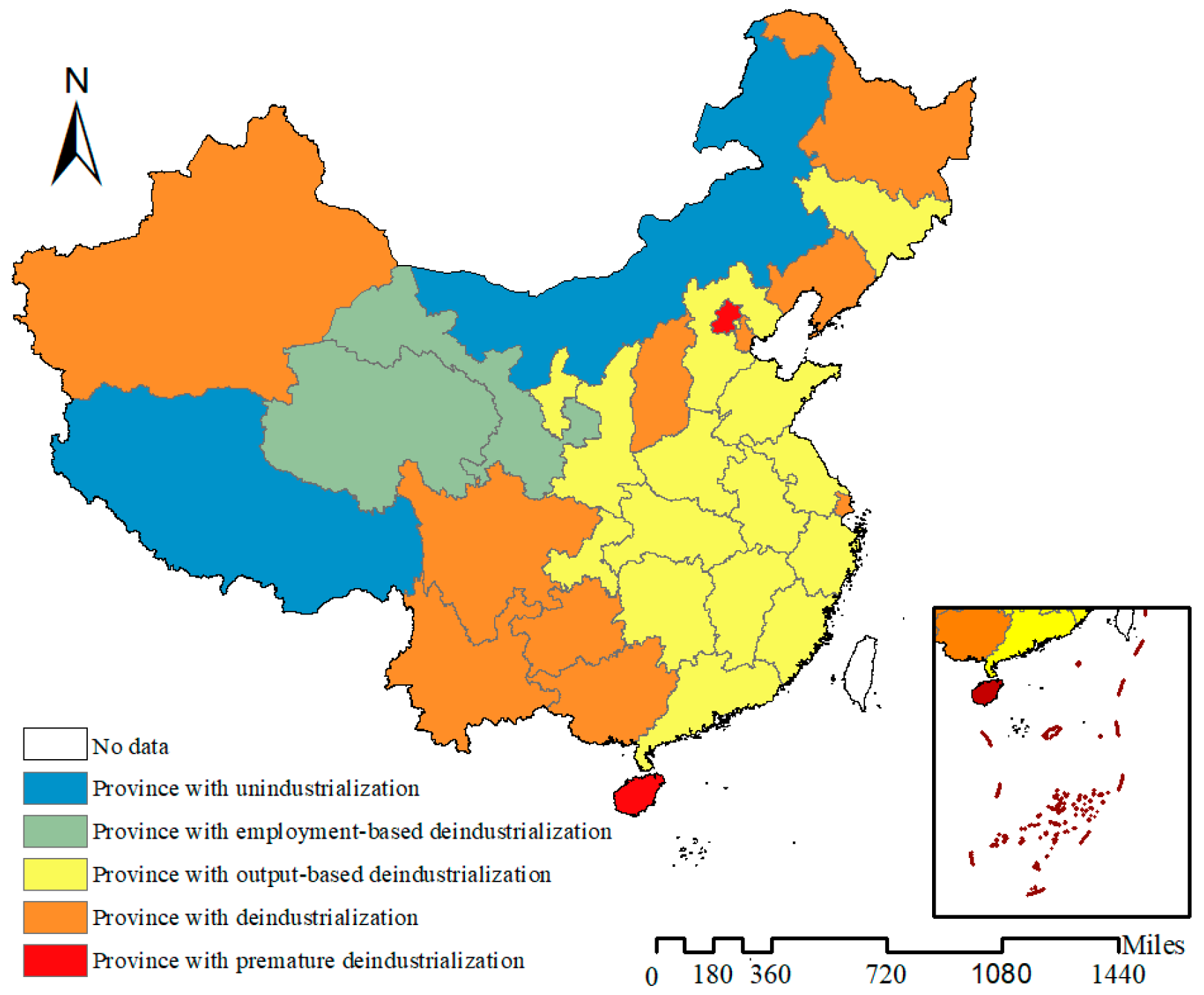
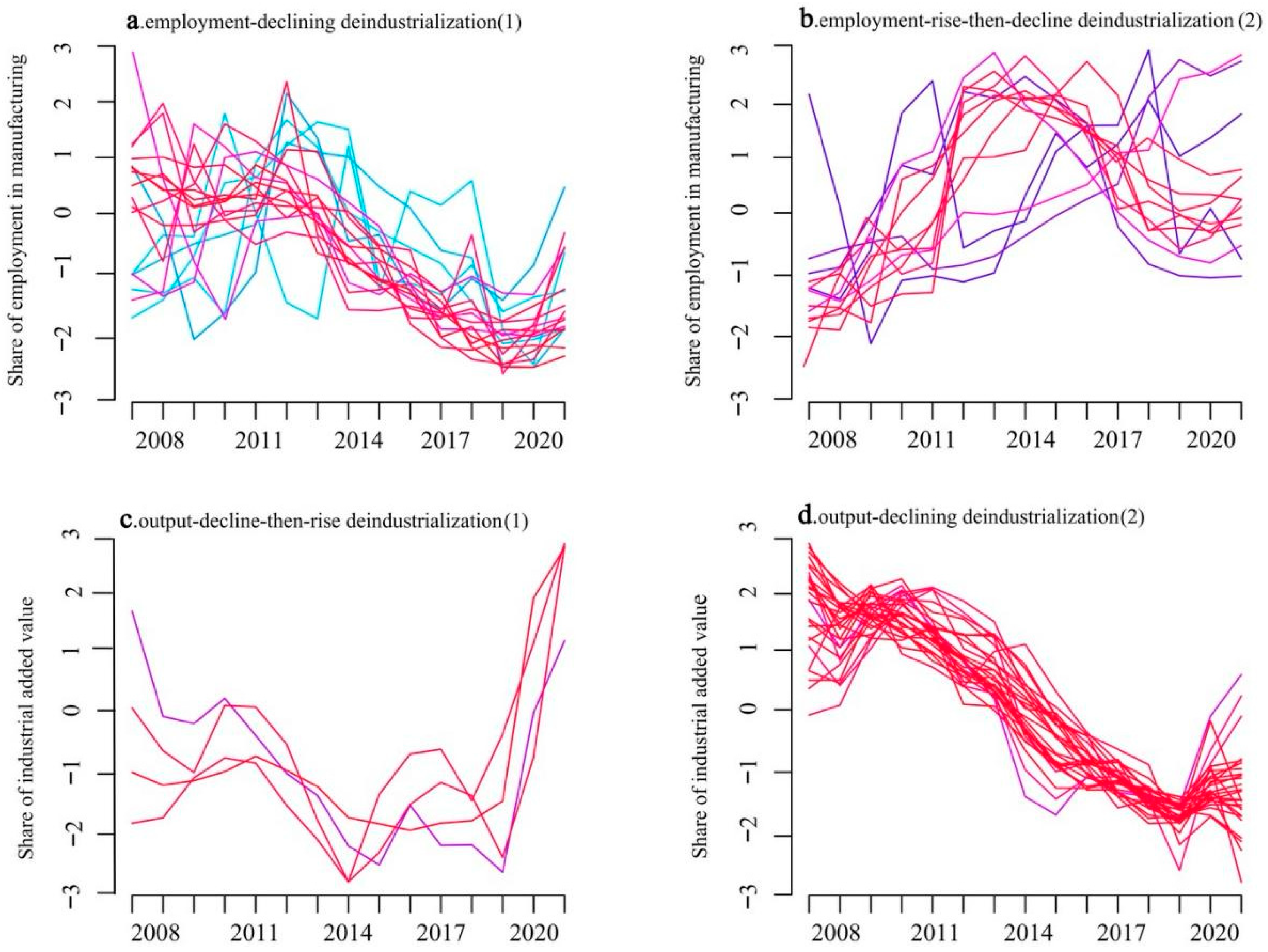
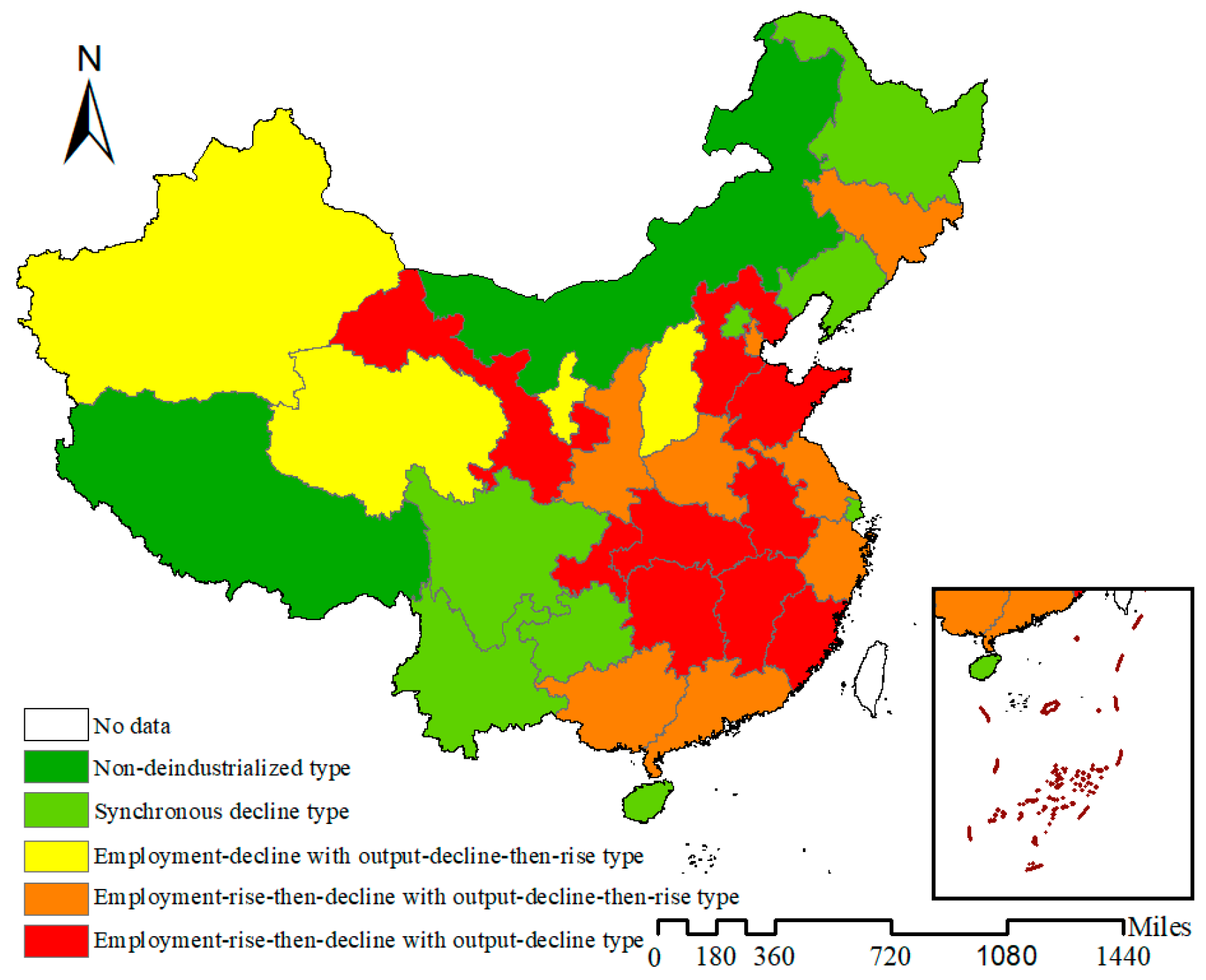
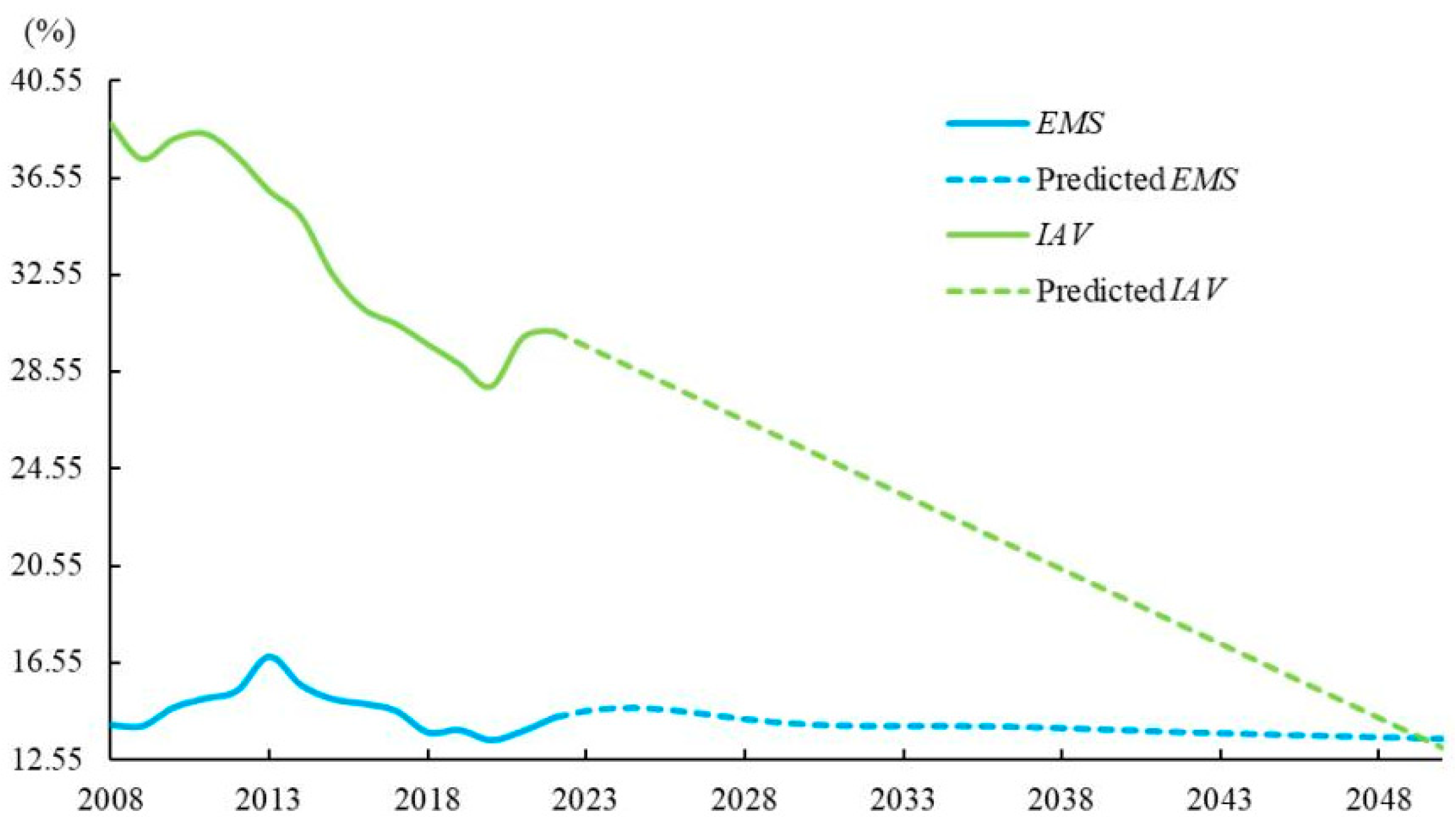

| Dimension | Code | Specific Indicators | Criteria |
|---|---|---|---|
| Share of manufacturing employment | EMS | Scale of employment in manufacturing, urban units, private enterprises self-employed sectors as a percentage of employment in secondary and tertiary industries | Continuous decline during five years; Five-year share average < 20.00% |
| Share of manufacturing value added | IAV | Industrial value added as a share of GDP * | Continuous decline during five years; Five-year share average < 20.00% |
| Illustrations | Displayed Formula | Interaction |
|---|---|---|
 | q(X1∩X2) < min(q(X1),q(X2)) min(q(X1),q(X2)) < q(X1∩X2) < max(q(X1),q(X2)) (X1∩X2) < min(q(X1),q(X2)) (X1∩X2) = q(X1) + q(X2) q(X1∩X2) > q(X1) + q(X2) | nonlinear weakened unifactor nonlinear weakened bifactor enhanced mutually independent nonlinear enhanced |
 denotes min(q(X1),q(X2));
denotes min(q(X1),q(X2));  denotes q(X1) + q(X2);
denotes q(X1) + q(X2);  denotes max(q(X1),q(X2));
denotes max(q(X1),q(X2));  denotes q(X1∩X2).
denotes q(X1∩X2). | Variable (Unit) | Code | Sample Size | Mean | Std. Dev. | Min | Max |
|---|---|---|---|---|---|---|
| Employment in the manufacturing industry as a share of secondary and tertiary industries (%) | EMS | 465 | 14.70 | 7.90 | 3.23 | 40.79 |
| Industrial value added as a share of GDP (%) | IAV | 465 | 33.64 | 9.50 | 7.05 | 57.38 |
| Nominal value added of the secondary sector (108 CNY) | NSI | 465 | 9823.92 | 9510.97 | 110.80 | 54,886.10 |
| Scale of manufacturing employment (104 persons) | ME | 465 | 299.71 | 371.28 | 2.50 | 1631.40 |
| Value added of the tertiary sector as a share of GDP (%) | VAP | 465 | 48.60 | 9.25 | 29.79 | 83.76 |
| Number of industrial establishments above designated size (units) | NEU | 465 | 12,761 | 14,702 | 56 | 70,702 |
| Number of effective invention patents of industrial enterprises above the designated size (pieces) | NIP | 465 | 24,369 | 57,915 | 19 | 572,589 |
| Resident population scale (104 persons) | RP | 465 | 4435.70 | 2872.34 | 292 | 12,684 |
| GDP per capita (CNY/person) | PGDP | 465 | 51,939.04 | 30,609.86 | 9697 | 189,988 |
| ME | NSI | VAP | NEU | NIP | RP | PGDP | |
|---|---|---|---|---|---|---|---|
| q(EMS) | 0.777 | 0.653 | 0.076 | 0.691 | 0.555 | 0.200 | 0.603 |
| p | 0.000 | 0.000 | 0.811 | 0.000 | 0.379 | 0.426 | 0.009 |
| q(IAV) | 0.139 | 0.208 | 0.460 | 0.175 | 0.103 | 0.132 | 0.321 |
| p | 0.964 | 0.414 | 0.027 | 0.690 | 0.999 | 0.675 | 0.223 |
| Enhancement | A | B | A + B (EMS) | C = A∩B | A + B (IAV) | C = A∩B |
|---|---|---|---|---|---|---|
| Nonlinear enhancement | ME | VAP | 0.853 | 0.901 | 0.599 | 0.921 |
| NSI | VAP | 0.729 | 0.830 | 0.668 | 0.866 | |
| RP | PGDP | 0.803 | 0.893 | 0.453 | 0.533 | |
| VAP | NIP | 0.631 | 0.675 | 0.563 | 0.807 | |
| VAP | RP | 0.276 | 0.309 | 0.592 | 0.723 | |
| VAP | NEU | 0.766 | 0.842 | 0.635 | 0.931 | |
| VAP | PGDP | 0.679 | 0.864 | 0.780 | 0.781 | |
| ME | NIP | 0.242 | 0.360 | |||
| ME | PGDP | 0.460 | 0.492 | |||
| NEU | NIP | 0.278 | 0.392 | |||
| NEU | RP | 0.307 | 0.319 | |||
| NEU | PGDP | 0.495 | 0.560 | |||
| NIP | RP | 0.235 | 0.355 | |||
| NSI | NIP | 0.311 | 0.439 | |||
| Two-factor enhancement | ME | NEU | 1.468 | 0.807 | 0.314 | 0.232 |
| ME | NSI | 1.431 | 0.815 | 0.348 | 0.270 | |
| ME | RP | 0.978 | 0.931 | 0.272 | 0.245 | |
| NIP | PGDP | 1.158 | 0.841 | 0.423 | 0.416 | |
| NSI | NEU | 1.344 | 0.759 | 0.383 | 0.281 | |
| NSI | PGDP | 1.256 | 0.909 | 0.529 | 0.525 | |
| NSI | RP | 0.854 | 0.815 | 0.341 | 0.329 | |
| ME | PGDP | 1.380 | 0.918 | |||
| ME | NIP | 1.332 | 0.836 | |||
| NEU | PGDP | 1.293 | 0.886 | |||
| NEU | NIP | 1.246 | 0.799 | |||
| NEU | RP | 0.891 | 0.855 | |||
| NIP | RP | 0.755 | 0.645 | |||
| NSI | NIP | 1.209 | 0.778 |
| Variable | Main | Wx | Spatial | Variance | LR Direct | LR Indirect | LR Total |
|---|---|---|---|---|---|---|---|
| lnME | 0.099 *** | 0.070 | 0.099 *** | 0.006 | 0.104 ** | ||
| (16.030) | (1.270) | (16.260) | (0.180) | (3.210) | |||
| lnNSI | 0.063 ** | −0.031 | 0.064 ** | −0.051 | 0.013 | ||
| (2.590) | (−0.170) | (2.860) | (−0.450) | (0.100) | |||
| VAP | 0.174 ** | −0.068 | 0.180 ** | −0.133 | 0.047 | ||
| (2.940) | (−0.160) | (3.210) | (−0.500) | (0.170) | |||
| lnNEU | −0.004 | −0.024 | −0.004 | −0.012 | −0.016 | ||
| (−0.990) | (−0.720) | (−0.880) | (−0.560) | (−0.740) | |||
| lnNIP | 0.005 * | 0.055 * | 0.004 | 0.032 * | 0.037 * | ||
| (2.050) | (2.390) | (1.650) | (2.070) | (2.310) | |||
| lnRP | −0.191 *** | −0.490 ** | −0.178 *** | −0.233 | −0.411 *** | ||
| (−5.780) | (−2.580) | (−5.220) | (−1.870) | (−3.410) | |||
| lnPGDP | −0.071 * | −0.137 | −0.066 * | −0.060 | −0.126 | ||
| (−2.410) | (−0.770) | (−2.350) | (−0.540) | (−1.040) | |||
| RHO | −0.672 *** | ||||||
| (−3.710) | |||||||
| R2 | 0.395 |
| Variable | Employment-Based Deindustrialization | Output-Based Deindustrialization | ||||||
|---|---|---|---|---|---|---|---|---|
| China | Eastern Region | Central Region | Western Region | China | Eastern Region | Central Region | Western Region | |
| ME | 0.102 *** | 0.179 *** | 0.115 *** | 0.066 *** | −0.009 ** | −0.024 *** | 0.005 | −0.013 ** |
| (0.007) | (0.016) | (0.009) | (0.008) | (0.005) | (0.007) | (0.006) | (0.006) | |
| NSI | 0.077 *** | 0.199 *** | 0.008 | 0.073 ** | 0.226 *** | 0.012 | 0.302 *** | 0.212 *** |
| (0.023) | (0.058) | (0.034) | (0.036) | (0.016) | (0.027) | (0.022) | (0.026) | |
| VAP | 0.155 *** | 0.107 | 0.136 | 0.057 | −0.423 *** | −0.698 *** | −0.363 *** | −0.445 *** |
| (0.060) | (0.143) | (0.112) | (0.092) | (0.042) | (0.067) | (0.070) | (0.067) | |
| NEU | −0.005 | −0.026 *** | 0.004 | 0.009 | −0.016 *** | 0.010 ** | −0.008 | −0.025 *** |
| (0.005) | (0.009) | (0.008) | (0.009) | (0.003) | (0.004) | (0.005) | (0.007) | |
| NIP | 0.004 | −0.021 *** | −0.014 *** | 0.006 | 0.008 *** | 0.004 | 0.007 ** | 0.011 *** |
| (0.003) | (0.006) | (0.005) | (0.004) | (0.002) | (0.003) | (0.003) | (0.003) | |
| RP | −0.251 *** | −0.403 *** | −0.238 *** | −0.263 *** | −0.214 *** | 0.044 | −0.488 *** | −0.248 *** |
| (0.031) | (0.061) | (0.078) | (0.072) | (0.022) | (0.028) | (0.049) | (0.053) | |
| PDGP | −0.113 *** | −0.191 *** | 0.036 | −0.110 *** | −0.209 *** | 0.011 | −0.234 *** | −0.236 *** |
| (0.028) | (0.064) | (0.039) | (0.040) | (0.020) | (0.030) | (0.025) | (0.029) | |
| R2 | 0.569 | 0.701 | 0.777 | 0.572 | 0.952 | 0.976 | 0.989 | 0.985 |
Disclaimer/Publisher’s Note: The statements, opinions and data contained in all publications are solely those of the individual author(s) and contributor(s) and not of MDPI and/or the editor(s). MDPI and/or the editor(s) disclaim responsibility for any injury to people or property resulting from any ideas, methods, instructions or products referred to in the content. |
© 2025 by the authors. Licensee MDPI, Basel, Switzerland. This article is an open access article distributed under the terms and conditions of the Creative Commons Attribution (CC BY) license (https://creativecommons.org/licenses/by/4.0/).
Share and Cite
Luan, Y.; Wang, Z.; Ren, J. The Spatiotemporal Heterogeneities of Deindustrialization in Mainland China. Systems 2025, 13, 1071. https://doi.org/10.3390/systems13121071
Luan Y, Wang Z, Ren J. The Spatiotemporal Heterogeneities of Deindustrialization in Mainland China. Systems. 2025; 13(12):1071. https://doi.org/10.3390/systems13121071
Chicago/Turabian StyleLuan, Yu, Zhibao Wang, and Jiamin Ren. 2025. "The Spatiotemporal Heterogeneities of Deindustrialization in Mainland China" Systems 13, no. 12: 1071. https://doi.org/10.3390/systems13121071
APA StyleLuan, Y., Wang, Z., & Ren, J. (2025). The Spatiotemporal Heterogeneities of Deindustrialization in Mainland China. Systems, 13(12), 1071. https://doi.org/10.3390/systems13121071








